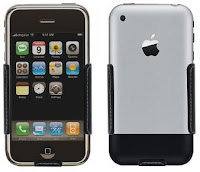
After six months of anticipation and years of rumors, Apple's iPhone - a cellular phone with computing and Wi-Fi capabilities - went on sale on June 29, 2007, rivaling the Macintosh as one of the most talked-about consumer electronics products ever.
Apple's chief executive, Steven P. Jobs, introduced the iPhone and an alliance with A.T.&T. (formerly Cingular) at the Macworld Expo in January. There are reports of a five-year exclusive relationship between the two companies; Apple has not yet announced international partners.
Apple's chief executive, Steven P. Jobs, introduced the iPhone and an alliance with A.T.&T. (formerly Cingular) at the Macworld Expo in January. There are reports of a five-year exclusive relationship between the two companies; Apple has not yet announced international partners.
Mr. Jobs apparently approached all of the major cellular carriers and avoided a partnership with Verizon, the nation's largest cellular phone company, because it was not willing to give Apple the revenue-sharing deal it was seeking.
The first two iPhone models are priced at $499 and $599 for four- and eight-gigabyte storage options, respectively. The phone does not have a hard disk. The system is based on a basic version of the Mac OS X operating system and comes with a 3.5-inch screen that can be used either vertically as a phone or turned horizontally to display video or still images.
The iPhone has three radios - cellular, Wi-Fi, and Bluetooth - and is advertised as having 5 hours of battery life and 16 hours of audio playback when used as a music player.
Less than a half-inch thick, the iPhone is designed to be controlled with a technique called "multi-touch," based on a series of gestures with one or two fingers. For example, it is possible to shrink or expand a picture on the screen by simply sliding thumb and finger apart or together.
The device itself won accolades for its elegant hardware and software design. It comes with only one mechanical button and a large touch-screen display that can be reconfigured depending on which application the user is running - phone, calendar, maps, mail, contacts, and so on.
The screen is bright and readable in direct sunlight. One industry insider who has worked with the machine said the L.C.D. screen alone probably costs about $80 to make. It includes three sensors, an accelerometer, a light sensor and a proximity sensor, making it possible to determine the orientation of the phone, whether the user is on the phone and whether it is inside or outside.
Mr. Jobs has asserted that the iPhone's Web browser is significantly more powerful than browsers in today's cellphones and other hand-held devices. - (John Markoff, June 6, 2007; updated July 2)
News about the iPhone, including commentary and archival articles published in The New York Times.
Related: Times Topics: Steve Jobs Apple Inc.
The first two iPhone models are priced at $499 and $599 for four- and eight-gigabyte storage options, respectively. The phone does not have a hard disk. The system is based on a basic version of the Mac OS X operating system and comes with a 3.5-inch screen that can be used either vertically as a phone or turned horizontally to display video or still images.
The iPhone has three radios - cellular, Wi-Fi, and Bluetooth - and is advertised as having 5 hours of battery life and 16 hours of audio playback when used as a music player.
Less than a half-inch thick, the iPhone is designed to be controlled with a technique called "multi-touch," based on a series of gestures with one or two fingers. For example, it is possible to shrink or expand a picture on the screen by simply sliding thumb and finger apart or together.
The device itself won accolades for its elegant hardware and software design. It comes with only one mechanical button and a large touch-screen display that can be reconfigured depending on which application the user is running - phone, calendar, maps, mail, contacts, and so on.
The screen is bright and readable in direct sunlight. One industry insider who has worked with the machine said the L.C.D. screen alone probably costs about $80 to make. It includes three sensors, an accelerometer, a light sensor and a proximity sensor, making it possible to determine the orientation of the phone, whether the user is on the phone and whether it is inside or outside.
Mr. Jobs has asserted that the iPhone's Web browser is significantly more powerful than browsers in today's cellphones and other hand-held devices. - (John Markoff, June 6, 2007; updated July 2)
News about the iPhone, including commentary and archival articles published in The New York Times.
Related: Times Topics: Steve Jobs Apple Inc.





















No comments:
Post a Comment